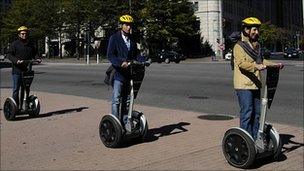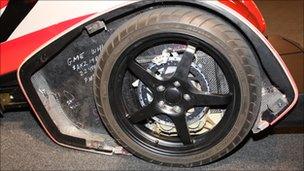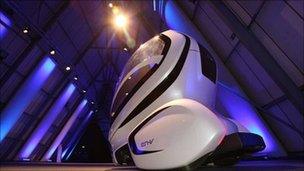General Motors shows vision of urban mobility
- Published
The BBC's Jorn Madslien went for a test drive
From inside the bubble, the futuristic EN-V feels like a living organism as it slowly rises from a crouching position, before balancing on two wheels as if they were legs.
Unlike a motorcycle, which has one wheel in front of the other, the two-seater electric car has one wheel on either side of its flimsy body.
The light-weight design makes it as agile as a ballet dancer. Turn the steering wheel hard to the side and the car, if that is indeed the best way to describe this peculiar vehicle, turns on a sixpence.
Push the wheel - which is more of an iPad-inspired joystick - forward and it surges ahead into a sprint at speeds of 25mph (40km/h) or more, depending on how the computer is programmed, delivering a 25 mile (40km) range per charge.
Travelling at such speeds may seem hazardous, given that the car has been designed without bumpers, air bags or any other conventional crash protection devices.
But according to the people who make it, the EN-V - short for electric networked vehicle - is smart enough to avoid collisions.
"Unlike a conventional car, which is designed to prevent its passengers and pedestrians in the event of a crash, the EN-V is more like an aircraft, in that it is designed to avoid crashing in the first place," explains Tom Brown from the research and development department at General Motors (GM).
Wealth of ideas
The EN-V is GM's vision of what urban cars could look like in the future.
Not necessarily its design, since the car's simple structure means it would be very easy to make and fit differently shaped polycarbonate and acrylic bodies to the frame.

The EN-V is basically a widened Segway, enclosed in a bubble
The two-wheel mobility solution is not integral to such a future either. This was developed to GM's specifications by the transport technology firm Segway, using gyroscopic and fluid-based levelling sensors to help the vehicle balance whilst on the move.
As such, the eye-catching prototype is really little more than a widened Segway, enclosed in a bubble, based on well-known and relatively simple technology.
What makes the bubble stand out, however, is the wealth of ideas contained within it; ideas that, if implemented, could change the way we live.
Autonomous driving
The most impressive attribute of the EN-V is its ability to communicate, both with other vehicles and with infrastructure such as satellites or buildings.
Sensors, cameras and a GPS system help the car see its surroundings and know its location.

The EN-V's two wheels are revealed once the sleek covers are removed
And although it is possible, and indeed great fun, to drive the EN-V manually, it is really designed to drive by itself.
Obviously, it cannot do this safely in streets where cars controlled by people might drive into it.
Instead, the EN-V was designed to operate within specially created zones, be they limited areas such as the Olympic Park in London or entire cities that only allow autonomously driven cars.
Reasonable cars
This might sound like science fiction, but it is not as far-fetched as it first seems.

GM's Tom Brown describes the EN-V as "another member of the family"
The vehicle has been trialled at the World Expo Shanghai, which is essentially a Chinese micro-city.
And with new mega-cities emerging all over the world, it is not only perfectly possible but perhaps even necessary to redefine how we travel within them.
There are good reasons why local and central governments might want to do so, such as traffic congestion and parking.
Besides, EN-Vs are designed to avoid collisions, so their weight can be dramatically reduced. Hence they would require less material to make and less energy to move, thus costs can be cut.
GM says its price tag would be a fifth of that on a conventional car, with running costs slashed to less than a third.
Endless possibilities
But it is the EN-V's functionality that really makes it attractive. Because it is autonomous, drivers could read, have teleconferences or sleep while being driven around in them. Because it is light and small, it could be driven onto fast-moving trains connecting cities. Because it is small, it would be easy to park - perhaps using some sort of stacking system.
Not that you would ever need to park it, however. The car could be on the move all day, without its owner being anywhere near it, sporadically charging its batteries at traffic lights or in dedicated charging stations.
Send it out in the morning to take the children to school, have it pick up a friend on its way back for a morning coffee. Travel in it to the local pool and make it pick up the shopping while you go for a swim.
Modify it for a child in a wheelchair and that child gains new independence. Similarly, blind people can suddenly go for drives on their own, and when they have reached their destination the car can head off on its own to find a place to park.
"It's like having another member of the family," grins Mr Brown. "It is an au pair on wheels, a private chauffeur, an individual cabin on a train. You can fill it with gadgets to keep you entertained or you can lean back and enjoy the view."
Major obstacles
But although the techies have come up with a way to revolutionise urban mobility, and though the list of compelling reasons why it makes sense can only grow longer, it could still prove difficult to make it happen - even with the urban planners on-board.

The EN-V's futuristic looks makes it an eye-catching way of showcasing vehicle-to-vehicle communication
For starters, laws would have to be changed. How would these vehicles be classified? Would you need a licence to drive one? Could they be exempt from current safety regulation?
And then there would be the difficulty of getting companies and governments to agree on standards they could all live with, which would be awkward to say the least if the current chaotic electric car-charging situation is anything to go by.
"If all the manufacturers don't come up with one common solution, it would defeat the whole idea," laments Mr Brown.
But whereas such obstacles might prevent or delay the introduction of the EN-V concept in a wholesale fashion, it will not prevent the ideas from entering the world of motoring.
In fact, much of it is here already - in particular vehicle to vehicle communication, known as v-to-v in techies' jargon.
"Ford Motor is working on v-to-v, BMW is doing it and we're working on it," says Mr Brown.
"Cars are already beginning to talk to each other, and we'll see much more of it in the future."